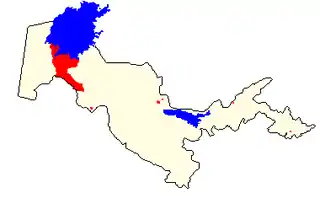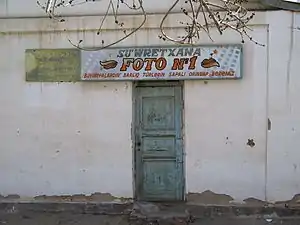Karakalpak language
Karakalpak (Karakalpak: Qaralqalpaq tili) is a Turkic language spoken by Karakalpaks in Karakalpakstan. It is divided into two dialects, Northeastern Karakalpak and Southwestern Karakalpak. It developed alongside Uzbek and neighboring Kazakh languages, being markedly influenced by both. Typologically, Karakalpak belongs to the Kipchak branch of the Turkic languages, thus being closely related to and highly mutually intelligible with Kazakh.[2]
| Karakalpak | |
|---|---|
| Qaraqalpaq tili, Қарақалпақ тили, قاراقالپاق تىلى | |
 Karakalpak in Latin, Cyrillic, and Perso-Arabic Nastaliq scripts. | |
| Native to | Uzbekistan, Kazakhstan, Turkmenistan |
| Region | Khwarazm |
| Ethnicity | Karakalpaks |
Native speakers | 583,410 (2010)[1] |
Turkic
| |
| Karakalpak alphabet (Latin, Cyrillic, Arabic script) | |
| Official status | |
Official language in | Karakalpakstan (Uzbekistan) |
| Language codes | |
| ISO 639-2 | kaa |
| ISO 639-3 | kaa |
| Glottolog | kara1467 |
 Map showing locations of Karakalpak (red) within Uzbekistan | |
Classification
Karakalpak is a member of the Kipchak branch of Turkic languages, which includes Kazakh, Bashkir, Tatar, Kumyk, Karachay, Nogai and Kyrgyz. Due to its proximity to Uzbek, much of Karakalpak's vocabulary and grammar has been influenced by Uzbek. Like the vast majority of Turkic languages, Karakalpak has vowel harmony, is agglutinative and has no grammatical gender. Word order is usually subject–object–verb.
Geographic distribution
Karakalpak is spoken mainly in the Karakalpakstan Autonomous Republic of Uzbekistan. Approximately 2,000 people in Afghanistan and smaller diaspora in parts of Russia, Kazakhstan, Turkey and other parts of the world speak Karakalpak.
Official status
Karakalpak has official status in the Karakalpakstan Autonomous Republic.
Dialects
Ethnologue identifies two dialects of Karakalpak: Northeastern and Southwestern. Menges mentions a third possible dialect spoken in the Fergana Valley. The Southwestern dialect has /tʃ/ for the Northeastern /ʃ/.
Phonology
Karakalpak has 25 native consonant phonemes and regularly uses four non-native phonemes in loan words. Non-native sounds are shown in parentheses.

Consonants
| Labials | Alveolar | Post-alv./ Palatal |
Velar | Uvular | Glottal | ||
|---|---|---|---|---|---|---|---|
| Nasal | m ⟨m/м⟩ | n ⟨n/н⟩ | ŋ ⟨ń/ң⟩ | ||||
| Stop | voiceless | p ⟨p/п⟩ | t ⟨t/т⟩ | k ⟨k/к⟩ | q ⟨q/қ⟩ | ||
| voiced | b ⟨b/б⟩ | d ⟨d/д⟩ | ɡ ⟨g/г⟩ | ||||
| Affricate | (t͡s ⟨c/ц⟩) | (t͡ʃ ⟨ch/ч⟩) | |||||
| Fricative | voiceless | (f ⟨f/ф⟩) | s ⟨s/с⟩ | ʃ ⟨sh/ш⟩ | x ⟨x/х⟩ | h ⟨h/ҳ⟩ | |
| voiced | (v ⟨v/в⟩) | z ⟨z/з⟩ | ʒ ⟨j/ж⟩ | ɣ ⟨ǵ/ғ⟩ | |||
| Approximant | l ⟨l/л⟩ | j ⟨y/й⟩ | w ⟨w/ў⟩ | ||||
| Rhotic | r ⟨r/р⟩ | ||||||
Vowels
| Front | Back | |||
|---|---|---|---|---|
| spread | rounded | spread | rounded | |
| Close | i ⟨i/и⟩ | y ⟨ú/ү⟩ | ɯ ⟨ı/ы⟩ | u ⟨u/у⟩ |
| Mid | e ⟨e/е⟩ | œ ⟨ó/ө⟩ | o ⟨o/о⟩ | |
| Open | æ ⟨á/ә⟩ | a ⟨a/а⟩ | ||
Vowel harmony
Vowel harmony functions in Karakalpak much as it does in other Turkic languages. Words borrowed from Russian or other languages may not observe rules of vowel harmony, but the following rules usually apply:
| Vowel | May be followed by: |
|---|---|
| a | a, ɯ |
| æ | e, i |
| e | e, i |
| i | e, i |
| o | a, o, u, ɯ |
| œ | e, i, œ, y |
| u | a, o, u |
| y | e, œ, y |
| ɯ | a, ɯ |
Vocabulary
Personal pronouns
| Singular | Plural | |
|---|---|---|
| 1st person | men 'I' | bizler 'we' |
| 2nd person | sen 'you' | sizler 'you (pl.)' |
| 3rd person | ol 'he/she/it' | olar 'they' |
Numbers
- bir 1
- eki 2
- úsh 3
- tórt 4
- bes 5
- altı 6
- jeti 7
- segiz 8
- toǵız 9
- on 10
- júz 100
- mıń 1000
- million 1000000
Writing system

Karakalpak was written in the Arabic and Persian script until 1932, in the Latin script from 1928 to 1940, after which Cyrillic was introduced. Following Uzbekistan's independence in 1991, the decision was made to drop Cyrillic and revert to the Latin alphabet. Whilst the use of Latin script is now widespread in Tashkent, its introduction into Karakalpakstan remains gradual.[3]
The Cyrillic, Latin, and Arabic alphabets are shown below with their equivalent representations in the IPA. Cyrillic letters with no representation in the Latin alphabet are marked with asterisks. The last changes to the new Karakalpak alphabet were made in 2016: instead of letters with apostrophes, letters with acutes were introduced.[4]
| Cyrillic | Latin | Arabic | IPA |
|---|---|---|---|
| Аа | Aa | ا / ـا | /a/ |
| Әә | Áá | ە / ـە | /æ/ |
| Бб | Bb | ب | /b/ |
| Вв | Vv | ۋ | /v/ |
| Гг | Gg | گ | /ɡ/ |
| Ғғ | Ǵǵ | ع | /ɣ/ |
| Дд | Dd | د | /d/ |
| Ее | Ee | ە / ـە | /e/ |
| Ёё* | yo | یو | /jo/ |
| Жж | Jj | ج | /ʒ/ |
| Зз | Zz | ز | /z/ |
| Ии | Ii | ى / ىـ | /i/ |
| Йй | Yy | ي / يـ | /j/ |
| Кк | Kk | ك | /k/ |
| Ққ | ق | /q/ | |
| Лл | Ll | ل | /l/ |
| Мм | Mm | م | /m/ |
| Нн | Nn | ن | /n/ |
| Ңң | Ńń | ڴ | /ŋ/ |
| Оо | Oo | و | /o/ |
| Өө | Óó | و | /œ/ |
| Пп | Pp | پ | /p/ |
| Рр | Rr | ر | /r/ |
| Сс | Ss | س | /s/ |
| Тт | Tt | ت | /t/ |
| Уу | Uu | وُ | /u/ |
| Үү | Úú | وُ | /y/ |
| Ўў | Ww | ۋ | /w/ |
| Фф | Ff | ف | /f/ |
| Хх | Xx | ح | /x/ |
| Ҳҳ | Hh | ه / هـ | /h/ |
| Цц | Cc | تس | /ts/ |
| Чч | Ch;ch | چ | /tʃ/ |
| Шш | Sh;sh | ش | /ʃ/ |
| Щщ* | sch | شش | /ʃtʃ/ |
| Ъъ* | |||
| Ыы | Íı | ى / ىـ | /ɯ/ |
| Ьь* | |||
| Ээ | Ee | ە / ـە | /e/ |
| Юю* | yu | يوُ | /ju/ |
| Яя | ya | يا | /ja/ |
Before 2009, C was written as TS; I and Í were written as dotted and dotless I.[5]
Sample Text
Article 1 of the Universal Declaration of Human Rights[6]
| Karakalpak text | English translation |
|---|---|
Ҳәмме Hámme адамлар adamlar өз óz қәдир-қымбаты qádir-qımbatı және jáne ҳуқықларында huqıqlarında еркин erkin ҳәм hám тең teń болып bolıp туўылады. tuwıladı. Оларға Olarǵa ақыл aqıl ҳәм hám ҳүждан hújdan берилген berilgen болып, bolıp, бир-бирине bir-birine туўысқанлық tuwısqanlıq руўхындағы ruwxındaǵı қатнаста qatnasta болыўы bolıwı тийис. tiyis. |
All human beings are born free and equal in dignity and rights. They are endowed with reason and conscience and should act towards one another in a spirit of brotherhood. |
Poets
- Ájiniyaz
- Berdaq Ǵarǵabay Ulí
- Kúnxoja
- Ibrayim Yusupov
See also
References
- Karakalpak at Ethnologue (18th ed., 2015) (subscription required)
- "Karakalpak". Ethnologue. Retrieved 2016-03-12.
- Birgit Schlyter (2012). "Language Policy and Language Development in Multilingual Uzbekistan". In Schiffman, Harold (ed.). Language Policy and Language Conflict in Afghanistan and Its Neighbors. Brill. p. 192.
- "Латын жазыўына тийкарланған қарақалпақ әлипбеси". Каракалпакский государственный университет им. Бердаха (in Kara-Kalpak). Archived from the original on 2017-12-24. Retrieved 2018-01-27.
- Karakalpak Cyrillic – (Old / New) Latin transliterator
- "Karakalpak (Қарақалпақ тили / Qaraqalpaq tili / قاراقالپاق تىلى)". omniglot. Retrieved 2023-08-19.
Bibliography
- Johanson, Lars; Csató, Éva Ágnes, eds. (1998), The Turkic Languages, London: Routledge, ISBN 9780415082006, OCLC 40980286
- Menges, Karl H. (1947), Qaraqałpaq Grammar, Translated from German by Leora P. Cunningham, New York: King's Crown Press, OCLC 3615928
